| |
 |
 |
 |
|
| equipment
list | | |
| I
tend to obsess over gear selection. I am fascinated by what motivates people to
choose particular pieces of equipment. You
can safely skip this page if you don't, and aren't. (Even then, though, you might
be interested to know that my entire studio resides in and on my computer. I do
not use outboard gear.)
What
follows is an overview of the equipment I have used for travel recording to date.
In the future
I hope to describe my very-high-quality, if much more cumbersome
and expensive, two-channel field recording rig, which is based on a Sound
Devices 722 harddrive recorder and a pair of Sennheiser
MKH-800 multi-pattern RF condenser microphones.
I also need to detail the more unusual microphones I use, including my Aquarian H2a hydrophone and piezoelectric contact mics. (At some point I may invest in a Core Sound TetraMic and 4Mic Ambisonics-inspired
surround recording system...)
The
things listed here are not my current recommendations.
Your requirements (and budget) (and approach to recording) will not be identical to mine. This is simply
a list of gear I've used, to satisfy those that continue to ask... a list which is most likely out of date by the time
you read this.

|  |
microphones
portable
recorders
transferring recordings
to the PC
editing on the PC
conversion to mp3
back
| |
microphones | | |
| For
my general thoughts on microphones, see this
page.
If
you're going traveling, protect your gear in a Pelican
case or similar. I prefer
the model 1150, which will comfortably hold a recorder, my mics in their windscreen,
and spare batteries. (Walking around, protect it in Ziploc bags.)
The
model 1200 will hold all of that and an SLR-sized camera. You can also fit over
a hundred blank minidiscs in it.
| | |
| For
the purposes of the Quiet American project I have used Sonic
Studios DSM dimensional stereo microphones almost exclusively, and always in the WHB windscreen
headband (shown). I
have owned many pairs of these mics: DSM-6/EH, DSM-6S/EH (three pair), and DSM-1S/M.
As Leonard, their maker, suggests, the DSM-6S series are the best suited for general-purpose
recording, and hence the backpacker. On
my honeymoon I also did a lot of recording with the DSM-1S/Ms, which have a lower
self-noise, but also a reduced capacity to tolerate high SPL — I did have
them 'clip' (distort) when recording loud sources. I prefer the flexibility and
character of the DSM-6S/EHs.
To
answer a question I am commonly asked: if I could have only one pair of microphones,
I would choose the DSM-6S/EHs ($650) in a WHB headband ($250).
Be
sure to buy extra socks for the WHB. In gusty environments I usually record with
'double socks.'
| 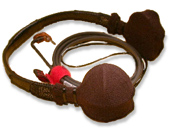
Sonic
Studios DSM series
in WHB headband | | | Not
long after I returned from my honeymoon I invested in the miniature
PA-24NJ preamp Leonard makes to complement his mics. I used it most recently
in Cuba and the Yucatan. It's
quite expensive (at nearly $1000, more expensive than the microphones themselves,
violating a good rule of thumb!) and while I can (just) hear benefits, and hence
always use it, it does not alleviate the Achilles' Heel of DSM microphones: their
relatively high self-noise.
While
this is not an issue for almost all the recording I do, I do not-infrequently
wish the DSMs were quieter than they are. If you are primarily interested in
quiet nature recording (or have been spoiled by very quiet professional condenser
microphones) this noise is something to be aware of.
| 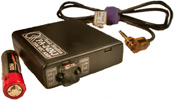
Sonic
Studios PA-24NJ preamp | | | I
also own and use a variety of other binaural-style microphones, partly because
I'm curious what various models are capable of, and partly out of my perpetual
quest to find the world's most quiet, invisible, and convenient binaural microphones.
Sometime I'd like to do recordings under controlled conditions with all of them
so you can hear how they stack up. The
two most notable binaural-style mics I own in addition to to my beloved DSMs are
Shure
WL183s and Core Sound's
deservedly popular High-End
Binaurals (HEB).
The
Shures are interesting primarily because they are quite high quality for their
low
cost (you can get a pair for under $200, note that they're sold individually).
They do require cables to adapt them for use with portable recorders like my minidisc
decks, however, as they come wired with neither standard XLR connectors or stereo
miniplugs. I had an adapter cable made for me by Dan
Dugan for less than $50 as I recall. | | |
The
Core HEBs (based on DPA 4060 series capsules) are very small — small enough
to fit inside my ear canals, allowing for true binaural recording. They require
a custom powering box that runs on a 9V battery however (as shown); the box itself
(which comes with the HEBs) is made of rugged metal and is not itself miniature.
The build quality of the HEBs (like the DSMs) is impeccable.
The
HEBs are discernibly quieter than the DSMs, but they are not natively as 'flat,'
their DPA capsules were optimized for speech reinforcement applications (such
as stage miking actors); this can be corrected for if it's noticeable in post-processing.
Concert tapers will want the version of these mics based on 4061 capsules, which
are slightly noisier but can stand higher SPL.
HEBs
run about $1000 a pair, almost 50% more than DSMs; as a result people have fabricated
their own sets of binaurals from DPA 4060s themselves, but Len at Core not only
provides a robust powering module and termination in a stereo miniplug, he also
matches capsules for each set, a key to good binaural imaging. Apparently the
DPA capsules vary quite a bit from capsule to capsule, so paying an expert to
match them for you is a good use of money.
Core
also makes low-cost
binaural microphones, ($75) which I acquired early on since I was curious
if I would notice much of a difference between them and more expensive options.
I did: they are noisier and their imaging is not as precise. But at the price
you may get a great deal. I haven't tried Core's midrange offering.
| 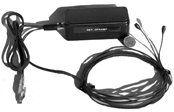
Core
Sound HEBs (high-end binaurals) 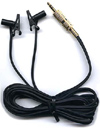
Core
Sound Low-Cost Binaurals | | | A
key consideration for all of these alternatives is how to mount them and how to
protect them from the wind; companies like Core offers no equivalent to the WHB.
Many people clip them to eyeglasses for a near-binaural approach, and use the
Microcat miniature
fur windjammer. Innovative
recordists have also made DIY windscreens from tea strainers and faux fur; I myself
have suggested that people on a budget attempt to replicate the wonderful WHB
design using old headphones (cord removed), alligator clips, baby socks, and the
wire cages that hold corks in champagne bottles...
| | | Based
on their popularity in Europe, I tried Soundman
OKM II ear-bud sized binaurals with their dedicated powering box.
To
my ear the do not provide nearly as flat, smooth, and detailed an image as my
DSMs, and I like several other people I know found them a bit 'harsh' in the upper
frequencies.
I
also thought their build quality was not very encouraging; the pair I have seemed
as if the wires to the capsules could easily pull out if they were strained.
| 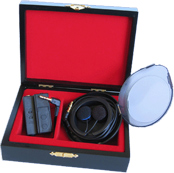
Soundman
OKM | | |
| Thinking
I might be interested in single-point stereo recording, I acquired but have never
been excited by the Audio
Technica AT822 ($300). It's a battery-powered mic is is designed to be used
with portable recorders; in addition to powering itself, it comes with an extra
cable that terminates in the stereo 1/8" miniplugs portable decks use.
As
discussed elsewhere, with a mic
like this, though you could hold it in your hand, you'll want a tripod, and wind
shielding whenever there's a breeze. This mic and others in its $300 price range
are not very quiet (no step up from my DSMs).
Slightly
cheaper and commonly available are Sony ECM series mics, which I've played with
but not owned. The ECM-MS907
is quite cheap ($100) and small, if not something I would rely on as a primary
microphone; the larger ECM-MS957
is reasonable well regarded in some circles, but not particularly quiet either
($300). Be
sure to buy windscreens.

|
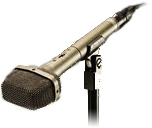
Audio
Technica AT822 
Sony
ECM-MS907 | | |
| portable
recorders | | |
| For
my general thoughts on portable recorders, see this page.
| | |
| In
Vietnam, I recorded using a Sharp
MS-722 and Sony MZ-R50
minidisc recorder. My
Sharp exhibited defects and I would hesitate to recommend it for that reason myself,
though I know people still using this deck years later with no problems. Mine
had what has come to be known as the 'UTOC
problem', in which the unit has trouble writing and consistently fails to
update its table of contents. This is unfortunate, as the jog-dial on this model
is a great interface. When
the Sharp failed, I bought a (probably smuggled) Japanese market Sony in Hanoi.
The Sony was rock-solid and never failed me once.
For years when people wrote asking which recorder to buy, I suggested they try
to find an MZ-R50 or MZ-R37
(its lower-shelf sibling) on eBay. As this model is almost ten years old I now
suggest people consider HiMD, which has many advantages. The
MZ-R50 is widely regarded
as the most rugged and reliable consumer minidisc deck ever made. I've owned
two and if I find one I will probably buy another blue one, just for nostalgia's
sake. I've carried
MZ-R50 or R37 with me on recent trips as a backup, so I never again am caught
in the field without a working recorder. In
Fiji, I recorded with a Sharp
MT-831. It never performed poorly, but the unit's eject button was weakly
constructed and I broke the button. On
my honeymoon, I recorded almost a hundred
disks with the Sharp
MT-66. In Kathmandu I purchased a Sony
MZ-R700 to replace it, as the contacts on the MT66's screw-on disposable AA
adapter wore down and became unreliable — I lost recordings several times
when the contact broke and the unit lost power, before the deck updated its table
of contents. Grrr. As
a result I recommend portable recorders that accept disposable batteries directly. The
MZ-R700 is mechanically noisy, but I picked it over more expensive models that
were also available because it accepts AA batteries inside the main case. The
last non-HiMD minidisc recorders I bought were the Sharp
MD-DR480 and, when that was stolen on our trip to Cuba, the nearly identical
DR7.
These
units were well-optimized for the stealth or field recordist and offered some
unusual features, including (on the DR480) the ability to 'preroll' — leave
the recorder in record-pause mode, but maintain a constant buffer of up to seven
seconds of audio, which is written when the unit is unpaused. It's
sad that it seems Sharp will never offer a version of these late-model decks incorporating
HiMD, such units would be close to perfect... The
only HiMD deck I've used so far is the Sony
MZ-RH10. The only thing differentiating it from the somewhat cheaper RH910
is that it has a bright organic LED display, which turns out to be great in the
dark (as expected) and often hard to read in bright sunlight (unexpected).
Perhaps as a completist I'll pick up a Sony
MZ-RH1 (or its nearly identical sibling, the MZ-M200), which has many advantages, including being able to upload not only
its own recordings via USB (as the RH10 can), but any older standard MD recordings
you may have made with other recorders.
|
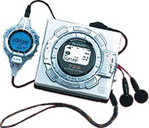
Sharp MS-722
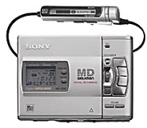
Sony MZ-R50 
Sony MZ-R37
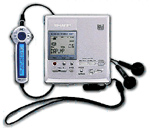 Sharp
MT-831 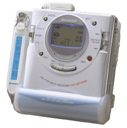
Sharp
MT-66 (in dock) 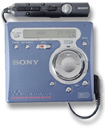
Sony
MZ-R700 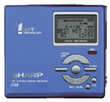
Sharp
MD-DR480 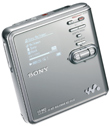
Sony
MZ-RH10 | | |
 My first foray into the new world of miniature memory recorders was the Samson's Zoom H2, which is as advertised a 'handy' little device that uses SD or SDHC memory cards as a medium. The interface is simple enough that I figured out how to use the device without cracking its manual. My first foray into the new world of miniature memory recorders was the Samson's Zoom H2, which is as advertised a 'handy' little device that uses SD or SDHC memory cards as a medium. The interface is simple enough that I figured out how to use the device without cracking its manual.
In addition to recording a wide range of file formats including mp3 at many bitrates and in uncompressed WAV up to high resolutions, it very unusually includes four built-in microphone elements and can record in four-channel surround. It can also mount directly on a photo tripod or audio boom.
One very nice feature about the H2 is that it can be used as a USB audio interface, allowing direct recording through either pair of its (quite nice!) stereo microphones.
For the price (under $200) it's a wonder — even if the microphone input is far too noisy -- by far the worst microphone input I've every used, so much so I would classify it as 'unsuable' with moderate to low-input microphones for anything but the loudest subjects.
|
|
|
Subequently, in anticipation of a trip to Kenya, I invested in the more contemporary Sony PCM-M10, which I would happily recommend as the best small recording device I have ever used (I exclude from the comparison the Sound Devices 7-series, which I would never call small).
 The M10 incorporates most of the best features of Sony's line of HiMD recorders, including unbelievable battery efficiency, a very well evolved interface, and exceedingly high quality preamps, with wonderful new features, such as built-in memory with automatic roll-over from external media without dropping a sample, uncompressed recording (up to 24/96), a pre-roll buffer, built-in declipping, a direct manual control knob for recording gain, quite high quality built-in stereo microphones, and (at last) access to a non-proprietary recording medium, in its case, microSD (as well as Sony's own Memorystick Pro format), and the ability to simply drag-and-drop recordings via USB. The M10 incorporates most of the best features of Sony's line of HiMD recorders, including unbelievable battery efficiency, a very well evolved interface, and exceedingly high quality preamps, with wonderful new features, such as built-in memory with automatic roll-over from external media without dropping a sample, uncompressed recording (up to 24/96), a pre-roll buffer, built-in declipping, a direct manual control knob for recording gain, quite high quality built-in stereo microphones, and (at last) access to a non-proprietary recording medium, in its case, microSD (as well as Sony's own Memorystick Pro format), and the ability to simply drag-and-drop recordings via USB.
As a final bonus, the PCM-M10 perfectly powers my Sonic Studios microphones, making the best small portable recording kit I've ever used.
Although more expensive than, say, the Zoom, the Sony is a truly remarkable piece of equipment, and I would without hesitation recommend it as an investment for recordists at all levels!
|
|
|
| 
In the
days before my HiMD and HD recorders, I occasionally used a Sony
PCM-M1 walkman-sized DAT recorder in addition to my MD decks. These days I
don't see much call for it, the technology is effectively extinct and not generally
commercially available. My
PCM-M1 was tweaked by Leonard Lombardo to match his microphones. I appreciate
the analog gain adjustment, illuminated display, superior preamplifier, and just-discernibly
superior clarity of recording. But it's simply not as easy to grab and use as
any minidisc decks. The
PCM-M1 was preferable to the similar silver TCD-D100 in that it did not impose
SCMS copy protection
on your recordings. | | |
| transferring
recordings to the pc | | |
| All
of the recorders I've used since my four-track days (minidisc, DAT, and
now harddrive and memory recorders) store data in digital files. The ability to quickly
move those files onto my PC has been
a slowly evolving art; corporate commercial interests
stood in the way of usability and convenience for many a year.
It is still a pain to transfer DAT and minidisc recordings, with the caveat that minidisc recordings can now be uploaded
with the Sony
MZ-RH1 HiMD recorder, using proprietary software;
once uploaded files can be stored in standard DRM-free formats, however.
(For an exhausting treatment of how to transfer minidisc recordings through older means, see my old advice here.)
Contemporary HD recorders, thankfully, generally connect directly to a computer via standard USB
or Firewire connections, and allow you to treat your recorder as generic portable storage volumes. Files are simply 'dragged-and-dropped' onto local drives.
Contemporary memory recorders do the same, but you can also simply remove your memory card and pop it into a $15 generic card reader — I recommend this latter technique, actually, as oddly enough it is generally much faster than transferring files through a portable recorder's own interface.
| | |
| editing
on the PC | | |
| Most
of the early compositions on this site were created using a creaky old Celeron
300A PC running at 450 MHz, which was built by Jim Roseberry at Studio Cat in 1998. I later used an Athlon XP 1900+ system also built by Jim in 2001, but over time upgraded the entire thing: power supply, motherboard,
Athlon processor, harddrives, until the entire thing but the case and soundcard was new. Like most people, now that they are powerful enough, I do most of my work on a laptop.

If
you intend to do audio work on a computer, it's well worth the effort to read up on what goes
into a good digital audio workstation (DAW). Although you can, you probably do not
want to simply buy a conventional home/office computer for dedicated audio work.
The most affordable option for a powerful and dedicated system is still to build your own desktop-style tower PC. Though not nearly as convenient as a laptop, you will get far more power and a much lower price; and it is precisely the things that are most valuable in a DAW that are compromised on in a laptop (harddrive speed, multiple drives, extensibility with a dedicated soundcard not hampered by a shared bus like USB). The one silver lining of a laptop is that most are quite quiet, with no loud fan!
If you can afford the premium, you'd be even better off turning to a hand-built system from one of the firms specializing in audio workstations. The people who customize these DAWs are invariably musicians themselves
experienced in selecting, installing, and testing components to make sure you
eek as much out of your machine as possible, and get as quiet a machine as possible
(quite important as machines tuned for gaming can be incredibly loud, not what
you want when working with fragile field recordings...).
The
good news is that regardless of what you end up with, today truly incredible things are possible on a relatively cheap computer. All of the work on this site was made with a PC that could be had now
for well under $500. It's hard to believe that media editing, even sound ending, was considered a taxing and exotic application of computers.
As
I wrote above, I do all my editing and composition on a
computer. I have a small mixer (the ubiquitous Mackie
1202) at the heart of my studio, but I don't use it as a mixing interface,
only to route all my various media decks — and to provide a nice physical
knob so I can turn down the racket when I do something foolish.
On
my old machine I mixed using a wonderful soundcard, the Yamaha
DSP Factory. The card is notable for containing the mixing power of a 24-channel
Yamaha digital console on board, including four-channel parametric EQ and dynamics
for every channel. Additionally, two onboard effects units provide usable if not
stunning effects. All of this without taxing the system CPU. Yamaha
has long since discontinued the DSP Factory; it's considered obsolete as among
other things it does not support high sampling frequencies (it does support 32-bit
samples). High sampling frequencies were not originally an issue for me, since
almost all of my source material was recorded at 44.1 kHz. As I acquire higher-resolution
recordings this will become more of an issue.
As
a result, my last desktop machine was built around the highly regarded RME
Digi96/PST, which had rock-solid low-CPU-load drivers and very good A/D converters.
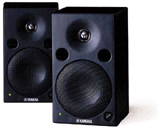  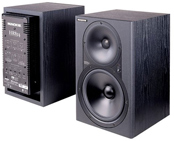
I
used to monitor on affordable, well built, overly bright, but crisp-imaging Yamaha
MSP5 nearfield monitors (at least they look a
bit like Genelecs). My friend Jhno
graciously lent me his Sunfire sub to fill out their sadly lacking bottom.
I
still use my MSP5s for home theater, and as the local monitoring for our new Korg SV-1 keyboard, but I upgraded my studio to the quasi-industry-standard
Mackie HR824
nearfields. They're larger, warmer, flatter, and much less ear-fatiguing to use
for hours at a time than the Yamahas.
Someday
I'd like to acquire another three for surround mixing, or at least three of their
smaller sibling, the HR624. I do still use the Sunfire with them, but that's not
really necessary.
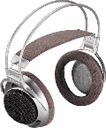  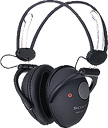  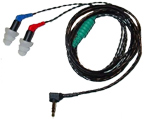
For
mixing I also use the extremely comfortable Sony
MDR-F1 headphones, which with their open-air design image more like monitors
than headphones normally do; and the very accurate but less comfortable collapsing
Sony MDR-D77 headphones. Both these models
have been superseded, but on occasion the F1s can still be found (as can the similar MDR-SA5000).
For
portable listening (e.g. to my quiPod)
I love, love, love, my Etymotic
ER4 earphones. They are the most accurate 'phones I've heard and their fantastic
isolation makes them a life-changing blessing in noisy environments like airplanes,
the BART transbay terminal, and buses (I have the 4Ps but also the cable that
adapts them to the more power-hungry but slightly more authoritative 4Ss). It's
a truism that mixing on headphones is 'dangerous' because you hear much more detail
with them than with monitors — detail that your listeners will not be able
to hear when they listen with a stereo. I
try to make sure that my work sounds good across all (stereo) playback platforms,
but I'm not as concerned as many people about delivering mixes that are optimized
for headphone listening, as that's where the binaural-like qualities of my recordings
shine. It's also for that reason that I include instructions to 'please listen
with headphones' in my CD packaging and in the introduction to this site.
I
edit and compose using Samplitude
Professional (marketed at various times under the SEK'D and Magix labels)
software; on my oldest machine I used C-Mexx's C-Console
to control the DSP Factory.
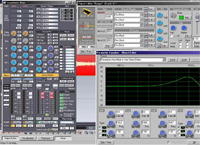
Samplitude, currently up to version 11,
is a wonderful, powerful, deep, and full-featured audio editing package, but it
isn't cheap. For years many people judged it as having the best-sounding audio engine of any host-based
editing system; to my ears, it certainly sounds extraordinairely good.
On my laptop, I'm still using the ancient version 6 which was already wonderful; and version 10. Samplitude is, alas, quite expensive; fortunately, there are also quite useable freeware or shareware editors available today, such as the popular Audacity.
I
also use a variety of software effects packages, including Elemental
Audio's Equium and InspectorXL,
Power Technology's DSP-FX, Cakewalk's Audio FX2
and FX3
packages, and the sonic timeworks
4080L reverb. Recently I've been using a host of freeware VST plug-ins as well
and I recently invested in OMG Software's Incoherence
after seeing it at a Dorkbot
meeting.
Makers
of audio software and hardware are more than welcome to send me copies of their
wares to work with, I'm happy to provide credit where it's due, and could always
use the sponsorship... cough. | |
| |
| | |
| My
favorite mp3 player
is still the fabulous and free WinAmp, it really whips the llama's ass.
These
days I produce mp3s directly out of Samplitude using the Xing
compressor (now owned by Real apparently) or LAME,
the popular free encoder. Very old mp3s on this site were made using the freeware
Canna MP3 Maker, which is apparently no longer being distributed.
I
currently compress to 320 kbps, which is usually all but indistinguishable from uncompressed WAV recordings.
Very
old fans may know I originally provided RealAudio copies of my recordings as well,
but as broadband became more ubiquitous (and support for playing mp3s while streaming
them) I halved my production work by removing them. I used Real Networks' RealProducer
to create the RealAudio files with a Basic version, which was grudgingly provided
free but very hard to find on the Real site. At
the time (and for all I know today also) RealAudio files could be hosted and streamed
without running a custom server or service. | | |
|  |
|

